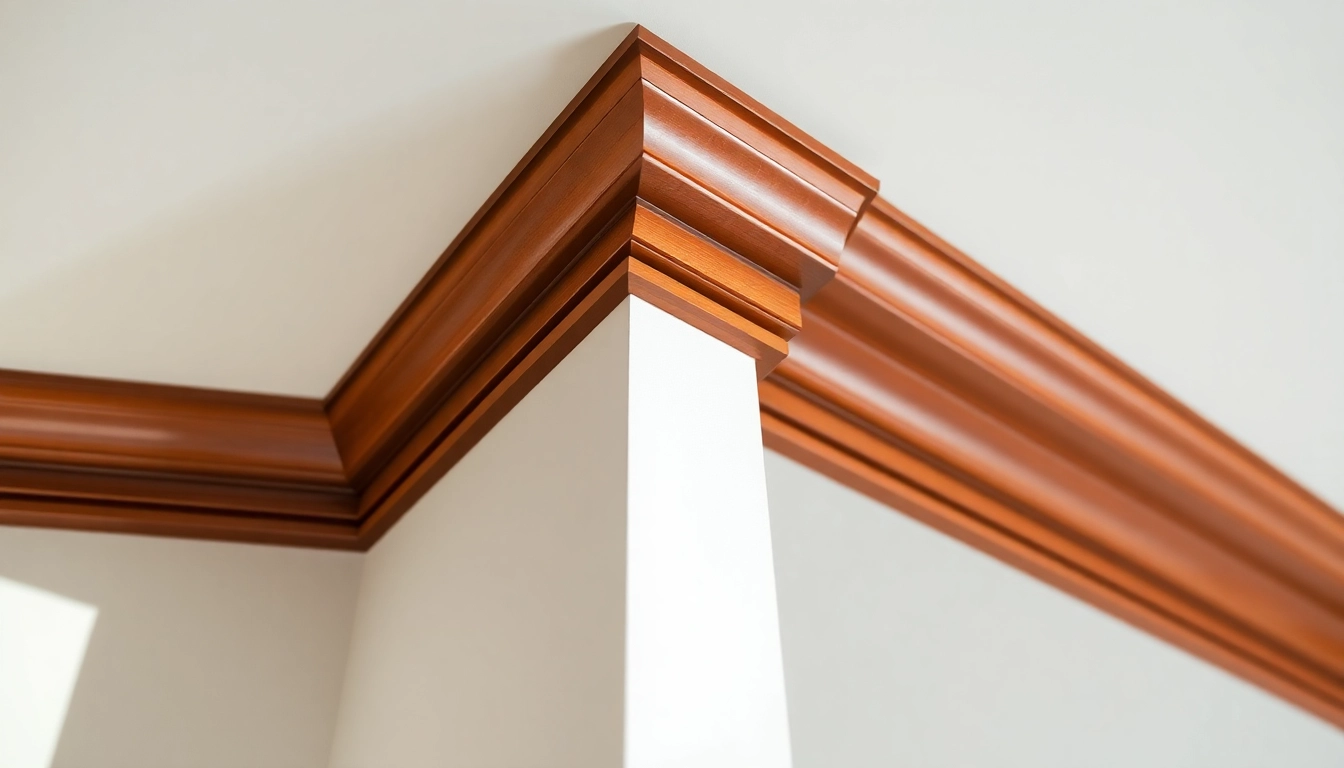Understanding Finish Trim: Styles and Applications
Finish trim plays a pivotal role in defining the aesthetic appeal and functional integrity of interior spaces. It encompasses the decorative and protective moldings that adorn walls, ceilings, doorways, windows, and floors, creating seamless transitions and polished details. Whether you are renovating an existing space or designing a new home, selecting the right finish trim enhances both visual harmony and structural precision. To explore a comprehensive range of options and professional guidance, visit Finish trim and discover how expert craftsmanship can elevate your interior design.
Types of finish trim for various rooms
The diversity of finish trim styles allows customization tailored to each room’s purpose and style. In living rooms and bedrooms, crown molding and cove molding are popular for adding character and elegance to ceilings. Baseboards provide a clean transition from wall to floor, often styled to match room decor—from traditional wood profiles to contemporary minimalist designs. In kitchens and bathrooms, water-resistant materials like PVC or composite trims are preferred, especially for areas prone to moisture.
For functional yet stylish accents, door casings and window trims frame openings precisely, with options ranging from simple flat profiles to ornate, detailed moldings. Specialty trims like chair rails mid-height on walls offer aesthetic diversity and protect walls from dents and scuffs. The choice of finish trim ultimately hinges on the room’s function, style, and moisture exposure, ensuring both durability and beauty.
Choosing the right finish trim style for your home
Selecting the ideal finish trim style involves considering architectural style, interior decor, and personal taste. Traditional homes often favor intricate moldings such as dentil crown molding, decorative rosettes, and elaborate baseboards. Contemporary interiors typically opt for sleek, clean-lined trims like flat boards and minimal profiles that blend seamlessly for a modern aesthetic.
A strategic approach is to analyze existing architectural elements. For instance, if your home features crown moldings, continuing with matching or complementary trims creates visual coherence. For a transitional style, mixing traditional and modern trims can provide an eclectic yet balanced look. Consulting design guides or a professional carpenter can help you identify styles that enhance your home’s character while maintaining harmony.
Design considerations and aesthetic impact
The design of finish trim influences perception of space, scale, and style. Larger, ornate moldings can add grandeur to spacious rooms, while slimmer profiles keep smaller spaces feeling open. The choice of material and finish also impacts visual texture—painted wood trims offer clean versatility, while stained or natural wood highlights craftsmanship and natural grain.
Color coordination is essential; white trim creates a crisp contrast in contemporary settings, whereas darker stains add warmth and depth in traditional spaces. Additionally, decorative trim details like dentil molding, ogee edges, or beadboard profiles evoke specific periods and styles, enriching the room’s narrative. Balancing these design elements ensures your finish trim complements other architectural features and interior decor themes.
Preparing for a High-Quality Finish: Tools and Materials
Selecting the best woods and composites
The foundation of a flawless finish trim lies in selecting appropriate materials. Traditional wood, such as pine, oak, or poplar, offers versatility and authentic appearance, suitable for staining or painting. Hardwood trims like oak provide durability and rich textures but can be costlier. Softwoods like pine are easier to work with and more affordable, making them popular for residential projects.
For moisture-prone environments, engineered composites such as PVC, MDF, or fiberboard provide resistance to warping, swelling, and pests. Modern composite trims can mimic natural wood’s appearance while offering enhanced longevity. When choosing between wood and composites, consider the room environment, desired finish, and maintenance needs.
Essential tools for precise finish carpentry
High-quality, specialized tools streamline installation and ensure a professional appearance. Key tools include:
- Measuring tapes and combination squares for precise measurements
- Miter saws for accurate angled cuts
- Chop or crosscut saws for cross-cutting lengths
- Contingent hand tools like Japanese saws for fine detail trimming
- Hammer and finish nails or nail guns for secure fastening
- Wood filler or caulk for sealing gaps and nail holes
- Sanding blocks or pneumatic sanders for smooth surfaces
- Level tools to ensure horizontal and vertical alignment
Paints, stains, and protective finishes for longevity
The final appearance and durability of your finish trim are heavily influenced by your choice of finish materials. High-quality latex or oil-based paints in satin, semi-gloss, or gloss sheens are preferred, as they resist scuffs and are easier to clean. For stained trims, water or oil-based stains can highlight the wood grain, followed by a clear polyurethane or varnish for protection.
In damp or high-traffic areas, using primers and sealants enhances adhesion and provides extra protection against moisture and wear. Consider environmental factors—such as VOC levels and indoor air quality—when selecting finish products, and always prepare surfaces adequately to maximize adhesion and finish quality.
Step-by-Step Guide to Installing Finish Trim
Measuring, cutting, and fitting techniques
Precise measurement begins with thorough analysis of room dimensions and corner angles. Mark measurements carefully on trim materials, adding allowances for mitered corners or overlaps. When cutting, employ a miter saw with sharp blades set to accurate angles, typically 45 degrees for corners, ensuring cuts are clean and exact.
Fitting involves dry-joining pieces to verify angles and lengths before fastening. Use furring strips or shims to achieve a snug fit, especially in uneven wall conditions. Always check for plumb and level; small adjustments during fitting save time during fastening.
Seamless mitering and corner finishing tricks
Miter joints are critical for a professional look. To achieve seamless intersections:
- Use a miter saw with a zero-clearance insert for cleaner cuts.
- Cut miters simultaneously on paired pieces with a miter clamp for consistency.
- Test fit multiple times and adjust as needed before nailing.
- Use corner blocks or biscuits for complex or tight corners.
A key tip is to slightly undercut the miter angles for tight joints, then fill gaps with caulk or wood filler, then sand for a perfect finish.
Securing and nail placement for flawless results
Proper securing ensures stability and reduces surface blemishes. Use finish nails or a pneumatic nail gun, placing nails approximately 16 inches apart along the length. Position nails slightly below the surface to facilitate filler application. Avoid over-driving nails to prevent denting or splitting, and countersink for easy filling.
Consider using adhesive for added stability, especially for large or heavy trims. After fastening, fill nail holes and gaps with wood filler or high-quality caulk, then sand smooth in preparation for finishing.
Achieving a Perfect Finish: Sanding, Painting, and Detailing
Surface preparation for smooth paint application
Surface preparation is paramount to achieving a seamless finish. After installation, inspect for rough edges or gaps; sand these areas with fine-grit sandpaper (220 grit). Sand all surfaces thoroughly to remove any splinters, tool marks, or irregularities, ensuring a smooth surface receptive to paint or stain.
Clean the dust thoroughly using a damp cloth or tack cloth, as residual debris can mar the finish. Priming is recommended for painted trims, especially when transitioning from raw wood or composite materials, to enhance adhesion and coloration.
Tips for painting or staining to enhance detail
Choose the right finish sheen based on the aesthetic desired—matte for understated elegance, semi-gloss or gloss for durability. For painting, apply in thin, even coats using high-quality brushes or rollers, allowing sufficient drying time between coats. For staining, use uniform strokes and wipe off excess to prevent blotching, then seal with a protective finish.
Use painter’s tape to mask adjacent surfaces for sharp edges. For intricate details, fine brushes or spray booths can improve precision while reducing drips and uneven coverage.
Final touches: caulking, touch-ups, and inspection
The finishing phase involves detailed inspection to identify imperfections. Apply high-quality caulk along corners and joints to fill gaps, then smooth with a caulk tool or finger. Touch up paint or stain as needed, and perform a final clean-up for a pristine appearance.
Maintenance and Enhancements for Your Finish Trim
Cleaning and periodic touch-up techniques
Regular maintenance prolongs the beauty and integrity of finish trim. Dust with a microfiber cloth or vacuum with brush attachment. For more stubborn dirt, use a damp cloth with mild soap; avoid harsh chemicals that can degrade paint or stain finishes.
Over time, small chips or scratches may appear. Keep a supply of matching touch-up paint or stain for quick repairs. Light sanding combined with reapplication of protective finish can restore the trim’s original luster.
Upgrading or repainting for aesthetic refresh
Refreshing your trim involves lightly sanding and repainting or staining. Consider changing the color scheme or finish sheen to update the room’s style without replacing trim entirely. Stripping old paint or stain may be necessary for significant changes, followed by a new coat of primer and finish.
Common issues and troubleshooting tips
Typical challenges include paint drips, uneven staining, gaps, or warping. Address paint drips by sanding and repainting, and correct gaps with caulk. Warping may require replacing affected pieces or reinforcing with additional support. Prevent such issues by proper material selection and precise installation procedures, taking care to acclimate trim materials to the environment before installation.
For optimal results, always use recommended products and professional techniques, and consult experienced carpenters or designers for complex projects.









